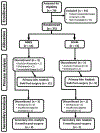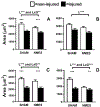Utility of Neuromuscular Electrical Stimulation to Preserve Quadriceps Muscle Fiber Size and Contractility After Anterior Cruciate Ligament Injuries and Reconstruction: A Randomized, Sham-Controlled, Blinded Trial
- PMID: 32631074
- PMCID: PMC7775613
- DOI: 10.1177/0363546520933622
Utility of Neuromuscular Electrical Stimulation to Preserve Quadriceps Muscle Fiber Size and Contractility After Anterior Cruciate Ligament Injuries and Reconstruction: A Randomized, Sham-Controlled, Blinded Trial
Abstract
Background: Anterior cruciate ligament (ACL) injuries and reconstruction (ACLR) promote quadriceps muscle atrophy and weakness that can persist for years, suggesting the need for more effective rehabilitation programs. Whether neuromuscular electrical stimulation (NMES) can be used to prevent maladaptations in skeletal muscle size and function is unclear.
Purpose: To examine whether early NMES use, started soon after an injury and maintained through 3 weeks after surgery, can preserve quadriceps muscle size and contractile function at the cellular (ie, fiber) level in the injured versus noninjured leg of patients undergoing ACLR.
Study design: Randomized controlled trial; Level of evidence, 1.
Methods: Patients (n = 25; 12 men/13 women) with an acute, first-time ACL rupture were randomized to NMES (5 d/wk) or sham (simulated microcurrent electrical nerve stimulation; 5 d/wk) treatment to the quadriceps muscles of their injured leg. Bilateral biopsies of the vastus lateralis were performed 3 weeks after surgery to measure skeletal muscle fiber size and contractility. Quadriceps muscle size and strength were assessed 6 months after surgery.
Results: A total of 21 patients (9 men/12 women) completed the trial. ACLR reduced single muscle fiber size and contractility across all fiber types (P < .01 to P < .001) in the injured compared with noninjured leg 3 weeks after surgery. NMES reduced muscle fiber atrophy (P < .01) through effects on fast-twitch myosin heavy chain (MHC) II fibers (P < .01 to P < .001). NMES preserved contractility in slow-twitch MHC I fibers (P < .01 to P < .001), increasing maximal contractile velocity (P < .01) and preserving power output (P < .01), but not in MHC II fibers. Differences in whole muscle strength between groups were not discerned 6 months after surgery.
Conclusion: Early NMES use reduced skeletal muscle fiber atrophy in MHC II fibers and preserved contractility in MHC I fibers. These results provide seminal, cellular-level data demonstrating the utility of the early use of NMES to beneficially modify skeletal muscle maladaptations to ACLR.
Clinical relevance: Our results provide the first comprehensive, cellular-level evidence to show that the early use of NMES mitigates early skeletal muscle maladaptations to ACLR.
Registration: NCT02945553 (ClinicalTrials.gov identifier).
Keywords: ACL; knee; rehabilitation; weakness.
Figures


References
-
- Arvidsson I, Arvidsson H, Eriksson E, Jansson E. Prevention of quadriceps wasting after immobilization: an evaluation of the effect of electrical stimulation. Orthopedics. 1986;9:1519–1528. - PubMed
-
- Beynnon BD, Fleming BC, Johnson RJ, Nichols CE, Renström PA, Pope MH. Anterior cruciate ligament strain behavior during rehabilitation exercises in vivo. Am J Sports Med. 1995;23(1):24–34. - PubMed
-
- Beynnon BD, Johnson RJ, Naud S, et al. Accelerated versus nonaccelerated rehabilitation after anterior cruciate ligament reconstruction: a prospective, randomized, double-blind investigation evaluating knee joint laxity using roentgen stereophotogrammetric analysis. Am J Sports Med. 2011;39(12):2536–2548. - PubMed
Publication types
MeSH terms
Associated data
Grants and funding
LinkOut - more resources
Full Text Sources
Medical
Research Materials

